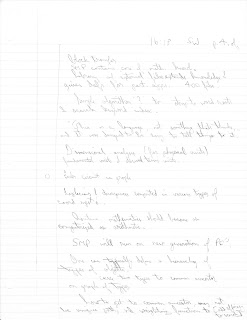Continuing from pp 1 - 3. This part contains some juicy tidbits that show how the principles underlying Wolfram's vision of a mathematical computer language have guided Mathematica's development to this day.

SMP contains the core of mathematical knowledge. A library of external files extends knowledge and gives definitions for particular applications; currently about 400 files.
Has a simple algorithm to strip to word roots and search a keyword index.
"This is a language, not something that thinks, and it was designed to be easy to tell things to it."
Dimensional analysis for physical units; fundamental units and derived terms' units.
Euler circuit in a graph (?)
Laplacian and divergences computed in various types of coordinate systems.
Routine mathematics should become as computerized as arithmetic.
SMP will run on a new generation of PCs.
One can typically define a hierarchy of types of objects. Then coerce two types to a common ancestor on a graph of types. How to get to the common ancestor? There may not be a unique path, so need a weighting function to [add efficacy to the search].
Vectorize: adds arrays of numbers in same number of operations as adding single numbers.
When to swap data with disc is left to the operating system. SMP needs a C compiler to work.
Gamma matrix manipulation.

SMP contains the core of mathematical knowledge. A library of external files extends knowledge and gives definitions for particular applications; currently about 400 files.
Has a simple algorithm to strip to word roots and search a keyword index.
"This is a language, not something that thinks, and it was designed to be easy to tell things to it."
Dimensional analysis for physical units; fundamental units and derived terms' units.
Euler circuit in a graph (?)
Laplacian and divergences computed in various types of coordinate systems.
Routine mathematics should become as computerized as arithmetic.
SMP will run on a new generation of PCs.
One can typically define a hierarchy of types of objects. Then coerce two types to a common ancestor on a graph of types. How to get to the common ancestor? There may not be a unique path, so need a weighting function to [add efficacy to the search].
Vectorize: adds arrays of numbers in same number of operations as adding single numbers.
When to swap data with disc is left to the operating system. SMP needs a C compiler to work.
Gamma matrix manipulation.





